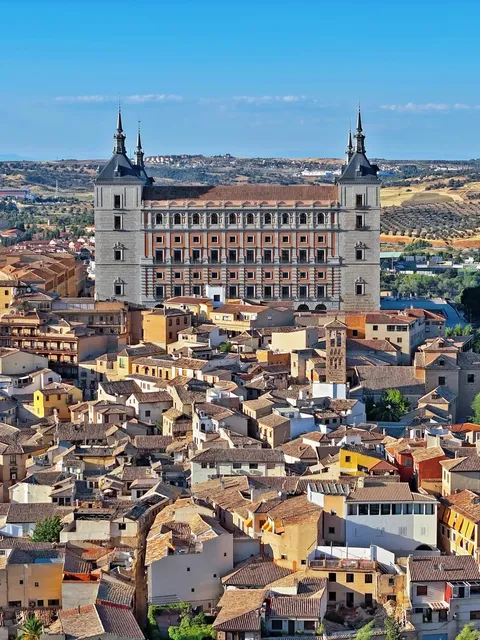The Monastery of San Juan de los Reyes in Toledo is an Isabelline style Franciscan monastery built by Isabella I of Castile (1477–1504). It is a UNESCO World Heritage Site. The monastery was founded in 1477 by Isabella I of Castile and Fernando II of Aragon to commemorate the victory at the Battle of Toro. It was dedicated to Saint John the Evangelist for use by Franciscan friars. The monastery is a masterpiece of Isabelline architecture, a style that combines Gothic and Mudéjar elements. The church has a single nave with a stellar vault. The cloister is Mudéjar in style, with a beautiful ceiling on the second floor. The monastery was badly damaged by Napoleon's troops during their occupation of Toledo in 1809. It was restored in the 19th century and is now open to the public. Here are some interesting facts about the Monastery of San Juan de los Reyes: The monastery was originally intended to be the burial place of Isabella and Fernando, but they were eventually buried in the Royal Chapel of Granada. The monastery's church contains the tomb of Prince Juan, the only son of Isabella and Fernando who died in childhood. The monastery's cloister is home to a collection of Mudéjar tiles, which are some of the finest examples of this type of tilework in Spain. The monastery is a popular tourist destination and is open to the public for tours. Would you like to know more about the Monastery of San Juan de los Reyes?
Construction and Architectural Style: Construction began in 1477 under the supervision of architect Juan Guas and was completed in 1504. The Isabelline style prominently features Gothic elements with intricate tracery and ribbed vaults, alongside Mudéjar influences like geometric patterns and horseshoe arches. Highlights: The main church stuns visitors with its stellar vault and richly decorated main chapel. The cloister, a tranquil haven, offers a beautiful example of Mudéjar ceilings with intricate designs. Look for the symbolic chains on the facade, commemorating Christian captives freed by the Catholic Monarchs. Visiting the Monastery: The monastery is open to the public for guided tours. Ticket prices vary starting at 4€. It's generally open year-round, except for December 25th and January 1st. Hours differ between winter and summer months, so it's recommended to check their official website for current...
Read moreThe Monasterio de San Juan de los Reyes is one of Toledo’s most impressive and underrated landmarks. This beautiful 15th-century monastery, commissioned by the Catholic Monarchs, is not only a marvel of Gothic architecture but also holds significant historical value.
Architecture: The monastery’s exterior is breathtaking, with its elaborate Gothic design and intricate stonework. The gargoyles and ornate details on the facade are worth admiring up close. Inside, the cloisters are serene and peaceful, with a beautiful blend of Gothic and Mudéjar styles. The ceiling and arches are particularly stunning, showcasing the intricate craftsmanship of the time. Walking through the quiet corridors, you can truly feel the history and spiritual significance of the place.
Historical Significance: The Monasterio was originally intended as the final resting place of the Catholic Monarchs, Queen Isabella I and King Ferdinand II, though they were eventually interred in Granada. The walls inside are adorned with coats of arms and chains symbolizing the liberation of Christian prisoners from Moorish captivity, a reflection of the Reconquista era.
Atmosphere: There’s an undeniable sense of tranquility here. Unlike some more crowded tourist sites in Toledo, the monastery feels like a peaceful retreat, making it a perfect spot for reflection or just to appreciate the history and beauty of this architectural masterpiece.
Conclusion: If you’re visiting Toledo, don’t miss the chance to explore the Monasterio de San Juan de los Reyes. It’s a historical gem that gives you a deep insight into Spain’s religious and political past. The architecture alone is worth the visit, but the peaceful atmosphere makes it a special experience. Highly recommended for history buffs, architecture lovers, and anyone seeking a bit of calm during their...
Read moreVisited in August 2024
This is a very beautiful Catholic Monastery in Toledo. Built in the 16th and 17th century, the monastery shows a mixture of late Gothic-Isabelline and Mudéjar styles. The Mudéjar style goes back to Muslims who fell under Christian rule in Spain after the Reconquista. The Mudéjar-style artesonado ceiling is a prominent design style incorporated. They included many craftsmen who, as master builders for Christian clients, had a great influence on the design of sacred buildings Characteristics of Islamic architecture, such as horseshoe arches, stalactite vaults, Moresque (surface decorations) and stucco ornaments were combined in the Mudéjar style with influences from the Christian Romanesque, Gothic, and Renaissance styles. Also typical were wooden ceilings, doors or prayer pulpits artistically decorated with geometric motifs and ribbed domes.
This monastery was founded by King Ferdinand II of Aragon and Queen Isabella I of Castile to commemorate both the birth of their son, Prince John, and their victory at the Battle of Toro (1476) over the army of Afonso V of Portugal.
The battle represented a decisive political victory for the Catholic Monarchs, assuring them the throne and paving the way for the future united kingdoms of Spain. Toledo was chosen as the site for building the monastery due to its central geographic location and because it had been the capital of the ancient Visigoth kingdom, symbolically reconstituted by Isabella and Ferdinand with the restoration of the lost unity of Spain, through the union of Castile...
Read more
